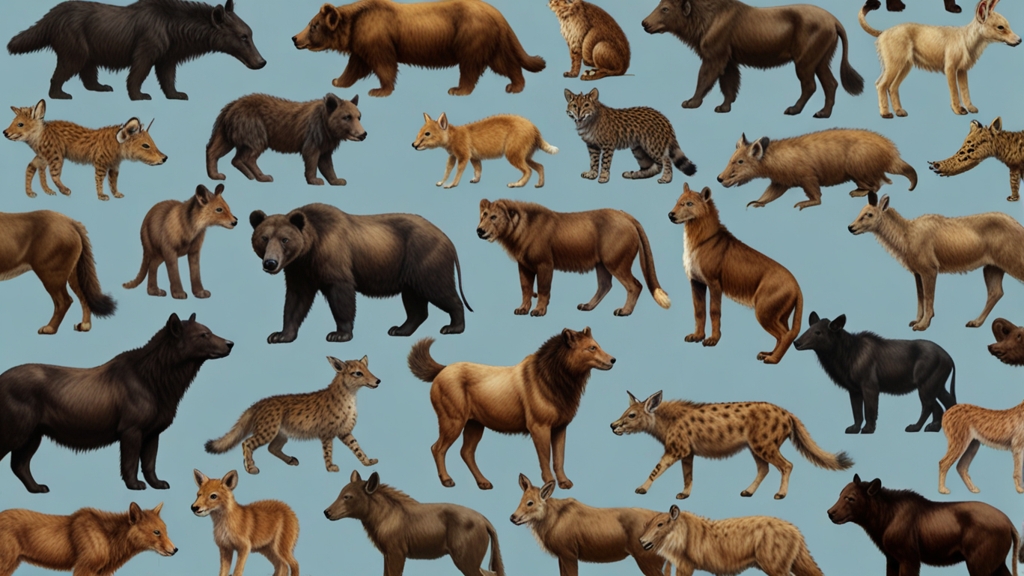The Dawn of Mammals: Early Beginnings
The journey of mammal evolution is a fascinating saga that started over 200 million years ago during the Mesozoic Era. At this time, dinosaurs dominated the landscape, and early mammals were small, nocturnal creatures that made up for their diminutive size with agility and keen senses. These early mammals, often no bigger than a modern shrew, laid the groundwork for the incredible diversity we see today.
Post-Dinosaur Dominance: Opportunity and Evolution
The extinction of dinosaurs around 65 million years ago marked a pivotal moment for mammals. The catastrophic event opened up ecological niches that allowed mammals to diversify rapidly. In what seemed like a blink of evolutionary time, mammals began to explore new habitats, leading to various forms and sizes ranging from tiny rodents to enormous mammoths.
The Great Diversification: Adapting to Ecological Niches
Diverse habitats fostered the evolution of myriad mammalian forms. Arboreal environments witnessed the rise of primates, while grasslands became the prowling grounds for large predators like lions and tigers. Marine environments saw the evolution of cetaceans, such as whales and dolphins, adapting perfectly to life in the water.
"From the frosty tundras where large, insulated mammals roam, to the dense rainforests abuzz with activity, mammals have shown a remarkable ability to adapt, evolve, and thrive in various environments. Their story is one of resilience and ingenuity." – Dr. Jane Feldman, Evolutionary Biologist
The Giants: Mammalian Behemoths
One of the most awe-inspiring aspects of mammal diversity is the emergence of gigantic species. Mammoths and mastodons once roamed the Earth, towering over other creatures. In our current era, the blue whale holds the title of the largest mammal ever, stretching up to 100 feet in length and weighing as much as 200 tons. Such giants are a stark contrast to the small, scurrying mammals from which they evolved.
Tiny Wonders: The Smallest Mammals
At the other end of the spectrum, some of the smallest mammals are equally fascinating. The Etruscan shrew, weighing just about 1.8 grams, holds the record for the smallest mammal by mass. These tiny creatures often exhibit incredibly high metabolic rates, enabling them to survive and thrive despite their size. Their miniaturized physiology offers a unique perspective on mammalian adaptability.
Diverse Orders and Adaptations
The class Mammalia encompasses numerous orders, each with distinct adaptations. Bats, for instance, have evolved the ability to fly, while moles have specialized in burrowing. Marsupials, such as kangaroos, possums, and koalas, showcase a different reproductive strategy, nurturing their young in pouches. These adaptations highlight the extraordinary versatility and innovation in mammalian evolution.
"Mammals exhibit an incredible array of adaptations that reflect their evolutionary pathways. From the echolocation of bats to the complex social structures of primates, each adaptation tells a story of survival and evolution." – Prof. Robert Lang, Zoologist
Human Impact and Conservation
Modern mammal diversity is as much a testament to evolutionary success as it is a narrative marred by challenges. Many mammalian species face threats from habitat destruction, climate change, and poaching. Conservation efforts are crucial in preserving the magnificent tapestry of mammal life for future generations. Understanding and protecting their habitats ensures the continued survival and thriving of these incredible creatures.
The Fascinating Future
As we look toward the future, the story of mammal evolution continues to unfold. Advances in science and technology enable us to understand the complexities of these creatures better, and ongoing conservation efforts provide hope for endangered species. The journey from tiny pledges to giant behemoths underscores the resilience and adaptability of mammals, promising an ever-evolving narrative of diversity.
"The future of mammals, much like their past, is a tapestry of challenges and triumphs. Our role in this ongoing story is to ensure that we protect the incredible diversity that has evolved over millions of years, fostering an environment where all species can continue to thrive." – Dr. Lina Sanchez, Conservation Scientist





